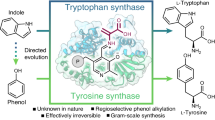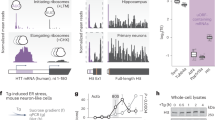Abstract
Human Cu,Zn superoxide dismutase (HSOD) is an Nα–acetylated enzyme, which may be useful in the prevention of post–ischemic damage. Since HSOD expressed in E. coli is not Nα–acetylated we have investigated expression and Nα–acetylation in yeast. HSOD has been expressed at very high levels in yeast utilizing the yeast glyceraldehyde phosphate dehydrogenase promoter. It is soluble, of normal specific activity and confers low level resistance to copper and zinc. The yeast HSOD is acetylated at its N–terminus indicating that yeast cells may be useful for the production of Nα–acetylated proteins.
This is a preview of subscription content, access via your institution
Access options
Subscribe to this journal
Receive 12 print issues and online access
$209.00 per year
only $17.42 per issue
Buy this article
- Purchase on Springer Link
- Instant access to full article PDF
Prices may be subject to local taxes which are calculated during checkout
Similar content being viewed by others
References
Kelbanoff, S.J. and Clark, R.A. 1978. The metabolic burst. p. 283–368. In: The Neutrophil: Function & Clinical Disorders, North-Holland, Amsterdam.
McCord, J.M. 1979. Superoxide, superoxide dismutase and oxygen toxicity, p. 109–125. In: Reviews in Biochemical Toxicology. Hodgson, E., Bend, J. R. amp; Philpot, R. M. (eds.), Elsevier North Holland Inc., New York.
McCord, J.M. 1985. Oxygen-Derived Free Radicals in Postischemic Tissue Injury. N. Engl. J. Med. 312: 159–163.
Flohe´, L., Giertz, H., and Beckmann, R. 1985. Free radical scavengers as anti-inflammatory drugs, p. 255–281. In: Handbook of Inflammation, Volume 5: The Pharmacology of Inflammation. Bonta, I. L., Bray, M. A., & Parnham, M. J. (eds.), Elsevier Science Publishers B.V.
Haber, F., Weiss, J. 1934. The catalytic decomposition of hydrogen peroxide by iron salts. Proc. R. Soc. London Ser. A. 147: 332–351.
Cohen, G. 1977. In defense of Haber-Weiss, p. 317. In: Superoxide and Superoxide Dismutases. Michelson, A. M., McCord, J. M., & Fridovich, I. (eds.), Academic Press, London.
Petrone, W.F., English, D.K., Wong, K., and McCord, J.M. 1980. Free radicals and inflammation: Superoxide-dependent activation of a neutrophil chemotactic factor in plasma. Proc. Natl. Acad. Sci. USA. 77: 1159–1163.
McCord, J.M., Keele, B.B. Jr., and Fridovich, I. 1971. An enzyme-based theory of obligate anaerobiois: The physiological function of superoxide dismutase. Proc. Natl. Acad. Sci. USA 68: 1024–1027.
Marklund, S.L., Holme, E., and Hellner, L. 1982. Superoxide dismutase in extracellular fluids. Clinica Chimica Act. 126: 41–51.
Kelly, K., Boux, H., Petkau, A., and Sehon, A. 1982. On the safety of treatment with bovine superoxide dismutase: production of a humoral antibody response in rabbits with repeated treatment. Can. J. Physiol. Pharmacol. 60: 1374–1381.
Flohe´, L., Biehl, G., Hofer, H., Kadrnka, F., Kölbel, R. and Puhl, W. 1980. Effectiveness of superoxide dismutase in osteoarthritis of the knee joint. Results of a double blind multicenter clinical trial, p. 424–431. In: Biological and Clinical Aspects of Superoxide and Superoxide Dismutase. Developments in Biochemistry, Vol. 11 B, Bannister, W. H., & Bannister, J. V. (eds.), Elsevier, New York.
Hallewell, R.A., Masiarz, F.R., Najarian, R.C., Puma, J.P., Quiroga, M.R., Randolph, A., Sanchez-Pescador, R., Scandella, C.J., Smith, B., Steimer, K.S., and Mullenbach, G.T. 1985. Human Cu/Zn superoxide dismutase cDNA: isolation of clones synthesising high levels of active or inactive enzyme from an expression library. Nucleic Acids Res. 13: 2017–2034.
Steinman, H.M. 1980. The amino acid sequence of copper-zinc superoxide dismutase from Bakers' yeast. J. Biol. Chem. 255: 6758–6765.
Travis, J., Owen, M., George, P., Carrell, R., Rosenberg, S., Hallewell, R.A., and Barr, P.J. 1985. Isolation and properties of recombinant DNA produced variants of human α1-proteinase inhibitor. J. Biol. Chem. 260: 4384–4389.
Beggs, J.D. 1978. Transformation of yeast by a replicating hybrid plasmid. Nature 275: 104–109.
Bolivar, F., Rodriguez, R.L., Greene, P.J., Betlach, M.C., Heyneker, H.L., and Boyer, H.W. 1977. Construction and characterization of new cloning vehicles II. A multipurpose cloning system. Gene 2: 95–113.
Maniatis, T., Fritsch, E.F., and Sambrook, J. 1982. Molecular Cloning, Cold Spring Harbor Laboratory, New York.
Sherman, F., Fink, G.R., and Hicks, J.B. 1982. Methods in Yeast Genetics, Cold Spring Harbor, New York.
Laemmli, U.K. 1970. Cleavage of structural proteins during the assembly of the head of bacteriophage T4. Nature 227: 680–685.
Erhart, E. and Hollenberg, C.P. 1983. The presence of a defective LEU2 gene on 2μ DNA recombinant plasmids of Saccharomyces cerevisiae is responsible for curing and high copy number. J. Bacteriol. 156: 625–635.
Forman, H.J. and Fridovich, I. 1973. On the stability of bovine superoxide dismutase. J. Biol. Chem. 248: 2645–2649.
Friedman, S.M. 1978. Biochemistry of Thermophily, p. 223–232. Academic Press, New York.
Malinowski, D.P. and Fridovich, I. 1979. Subunit association and side chain reactivities of bovine erythrocyte superoxide dismutase in denaturing solvents. Biochemistry 18: 5055–5060.
Valentine, J.S. and Pantoliano, M.W. 1981. Protein-metal ion interactions in cuprozinc protein (Superoxide Dismutase) p. 291–358. In: Metal Ions in Biology, Volume III. Spiro, T. G. (ed.), John Wiley & Sons, NY.
Fee, J.A. 1982. Is superoxide important in oxygen poisoning? Trends Biochem. Sci. 7: 84–86.
Karin, M., Najarian, R., Haslinger, A., Valenzuela, P., Welch, J., and Fogel, S. 1984. Primary structure and transcription of an amplified genetic locus: The CUP1 locus of yeast. Proc. Natl. Acad. Sci. USA 81: 337–341.
Fogel, S. and Welch, J.W. 1982. Tandem gene amplification mediates copper resistance in yeast. Proc. Natl. Acad. Sci. USA 79: 5342–5346.
Marklund, S. and Marklund, G. 1974. Involvement of the superoxide anion radical in the autoxidation of pyrogallol and a convenient assay for superoxide dismutase. Eur. J. Biochem. 47: 469–474.
Aberth, W., Straub, K.M., and Burlingame, A.L. 1982. Secondary ion mass spectrometry with cesium ion primary beam and liquid target matrix for analysis of bioorganic compounds. Anal. Chem. 54: 2029–2034.
Jabusch, J.R., Farb, D.L., Kerschensteiner, D.A., and Deutsch, H. 1980. Some sulfhydryl properties & primary structure of human erythrocyte superoxide dismutase. Biochemistry 19: 2310–2316.
Brown, J.L. and Roberts, W.K. 1976. Evidence that approximately eighty per cent of the soluble proteins from Ehrlich ascites cells are Nα-acetylated. J. Biol. Chem. 251: 1009–1014.
Brown, J.L. 1979. A comparison of the turnover of α-N-acetylated and nonacetylated mouse L-cell proteins. J. Biol. Chem. 254: 1447–1449.
Dayhoff, M.O. 1978. Atlas of protein sequence and structure. National Biomedical Research Foundation, Silver Spring, MA.
Tsunasawa, S., Stewart, J.W., and Sherman, F. 1985. Amino-terminal processing of mutant forms of yeast iso-1-cytochrome c. J. Biol. Chem. 260: 5382–5391.
Wold, F. 1984. Acetylated N-terminals in proteins-a perennial enigma. Trends Biochem. Sci. 9: 256–257.
Hartz, J.W. and Deutsch, H.F. 1972. Subunit structure of human superoxide dismutase. J. Biol. Chem. 247: 7043–7052.
Heinrikson, R.L., Krueger, E.T., and Keim, P.S. 1977. Amino acid sequence of phospholipase A2-α from the venom of Crotalus adamanteus. J. Biol. Chem. 252: 4913–4921.
Böhlen, P., Stein, S., Stone, J., and Udenfriend, S. 1975. Automatic monitoring of primary amines in preparative column effluents with fluorescamine. Anal. Biochem. 67: 438–445.
Bidlingmeyer, B.A., Cohen, S.A., and Tawin, T.L. 1984. Rapid analysis of amino acids using pre-column derivitization. J. Chromatography 336: 93–104.
Author information
Authors and Affiliations
Rights and permissions
About this article
Cite this article
Hallewell, R., Mills, R., Tekamp-Olson, P. et al. Amino Terminal Acetylation of Authentic Human Cu,Zn Superoxide Dismutase Produced in Yeast. Nat Biotechnol 5, 363–366 (1987). https://doi.org/10.1038/nbt0487-363
Received:
Accepted:
Issue Date:
DOI: https://doi.org/10.1038/nbt0487-363



